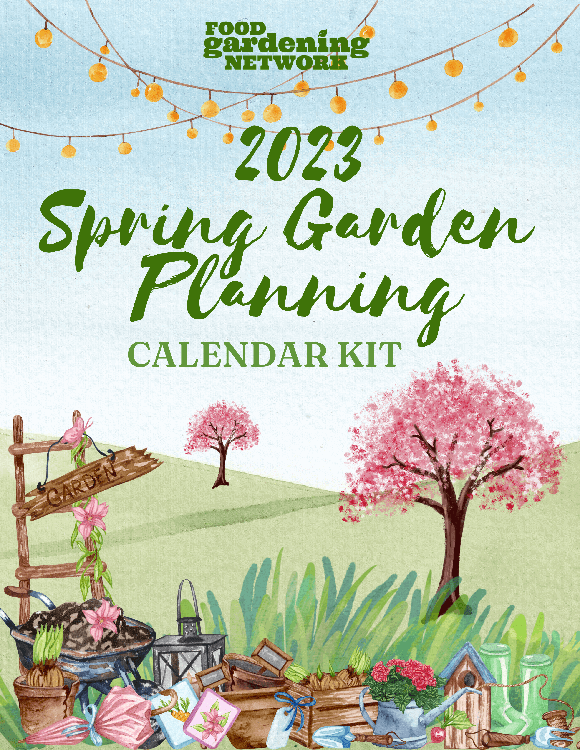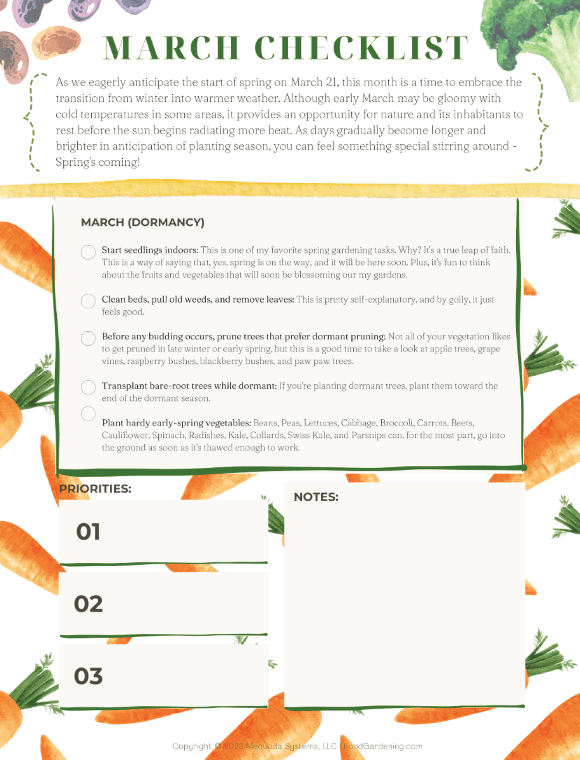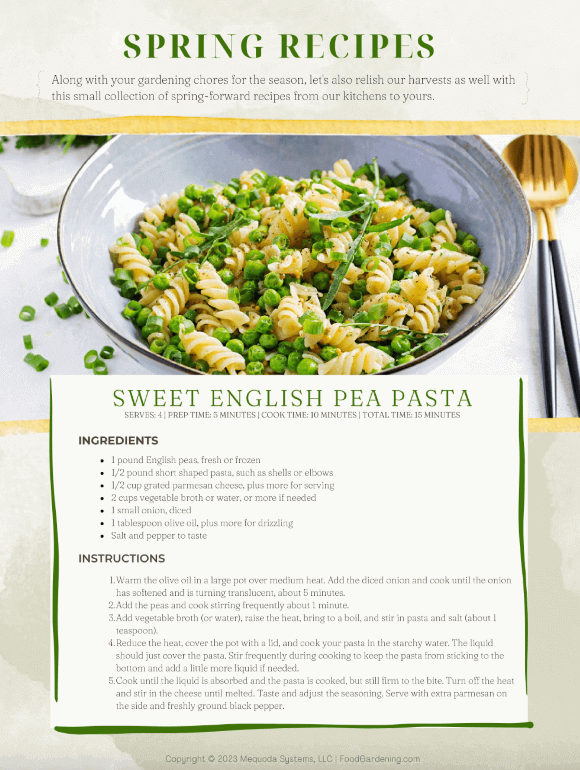
Friends, it is officially spring. The sun is out, the skies are blue, and the local flora and fauna are appearing. There’s a robin in a tree near my window sitting in his new nest, and the daffodils are spreading their colorful joy all over the place. Of course, I’m in New England, so it’s still on the chilly side, but I already have my spring gardening checklist up and ready.
Spring is an exciting time for us gardeners. It’s a busy time, too! After a winter of planning and anticipation, spring is when we turn all our dreams into reality. We go from starting our seedlings indoors to harvesting radishes, peas, lettuces, zucchini, squash, garlic scapes, asparagus, strawberries, and so much more, all within a short couple of months. It’s truly one of the most magical times of the year!
To be honest, though, with so much happening in the garden in spring, I need a checklist. I tried to just rely on memory or “instinct,” and that just doesn’t work. At least not for me. Luckily, I learned my lesson and now have a spring gardening checklist I love.
Discover 7 top tips for growing, harvesting, and enjoying tomatoes from your home garden—when you access the FREE guide The Best Way to Grow Tomatoes, right now!
A spring gardening checklist you can count on
 There are a few things I need to mention before we dive into the actual checklist. What I have here is just part of a larger Food Gardening Network 2023 Spring Garden Planning Calendar Kit (see to the right). So, if you’re the type of gardener who, like me, enjoys an illustrated calendar with monthly dates, tips, and plenty of room for taking notes and writing down priorities, I would encourage you to check out the printable kit. It comes free with a membership to the Food Gardening Network.
There are a few things I need to mention before we dive into the actual checklist. What I have here is just part of a larger Food Gardening Network 2023 Spring Garden Planning Calendar Kit (see to the right). So, if you’re the type of gardener who, like me, enjoys an illustrated calendar with monthly dates, tips, and plenty of room for taking notes and writing down priorities, I would encourage you to check out the printable kit. It comes free with a membership to the Food Gardening Network.
As for the spring gardening checklist itself, tasks are sectioned into months, with cooler weather tasks in March, all the way through harvesting and succession planting in June. Ready to begin? Let’s get that garden going!
March gardening checklist
- Start seedlings indoors.
- Clean garden beds, pull old weeds, and remove leaves.
- Prune trees that prefer dormant pruning. Apple trees, grape vines, raspberry and blackberry bushes, and pawpaw trees can all be pruned now.
- Transplant bare root trees while dormant. Plant dormant trees toward the end of the dormant season.
- Plant hardy early-spring vegetables. Beans, peas, lettuces, cabbage, broccoli, carrots, beets, cauliflower, spinach, radishes, kale, collards, Swiss kale, and parsnips can, for the most part, go into the ground as soon as it’s thawed enough to work.
April gardening checklist
- Start fast-growing seedlings indoors.
- Plant bare root trees.
- Test and amend your soil. A little effort here goes a long way.
- Add fresh mulch or another weed barrier. Mulch helps stabilize the soil temperature and prevent weeds.
- Work organic matter like compost into the soil.
- Compost. Set up your compost area.
- Plant hardy perennials. Herbs that can be planted on the last frost date can go in the ground.
- Plant spring trees and shrubs. These include apples, berries, figs, mulberries, and cherries.
- Plant hardy early-spring fruits and vegetables. These include grapes, asparagus, rhubarb, strawberries, chives, blueberries, raspberries, apples, peaches, and potatoes.
May gardening checklist
- Check or install irrigation lines.
- Divide perennials.
- Prune flowering trees post-bloom. Peach and cherry trees prefer to be pruned right as they are budding.
- Keep weeds in check.
- Plant spring bulbs. These include onions, garlic, leeks, shallots, spring onions, and fennel.
- Bring houseplants outside. Beware of overnight temperature drops and bring the plants back in if needed.
- Add straw below strawberries. This keeps strawberries off the ground.
- Plant flowers for pollinators. These include borage, calendula, cornflowers, marigolds, nasturtiums, and sunflowers.
- Plant post-frost fruits and vegetables. These include blueberries, raspberries, chives, apples, peaches, potatoes, melons, summer squash, winter squash, corn, okra, and nightshades.
- Harvest early-spring crops. Early-spring crops include asparagus, beetroot, peas, radishes, rhubarb, and carrots.
June gardening checklist
- Harvest late-spring crops. Harvest leafy greens, peas, asparagus, rhubarb, and strawberries. Allow asparagus to grow fronds for next season, and leave some rhubarb foliage to strengthen roots.
- Plant. Plant everything!
- Clear or clean spring vegetables.
- Feed your soil.
- Prune suckers. Plants like tomatoes have “suckers” that need plucking so that the plants focus on fruits now and not new stalks and leaves.
- Dump standing water. No mosquitoes, please!
- Invite pollinators. Bring out the bird seed, bug hotels, and bright plants.
- Begin succession planting. Start the next round of leafy greens, carrots, radishes, etc.
- Plant trap crops. Marigolds, nasturtium, and other trap crops will draw pests like aphids away from your vegetables.
Now, that’s the spring gardening checklist, but what are we going to do with all those delicious fresh vegetables when harvest times comes? Of course, you can find recipes anywhere. But one other thing I really like about what we did with the Food Gardening Network 2023 Spring Garden Planning Calendar Kit is that it includes a selection of recipes that highlight spring vegetables—Cream of Asparagus Soup, Shaved Radish Salad, Garlic Scape Chicken, and Rhubarb Comfort Crumble are all there! That’s a complete meal you can serve to guests!
When to plant in YOUR area
The spring gardening checklist is a helpful tool, as is the Food Gardening Network 2023 Spring Garden Planning Calendar Kit.
It’s also probably no surprise that your planting dates will be a little different in the hill country of Texas than they are along the coast of Maine. To that end, check out Almanac.com’s planting calendar, which is a helpful resource as well, for determining when to plant in your zone. You can enter your zip code, and they’ll give you the earliest dates to plant in the spring and the last days you can plant in the fall, based on the average frost dates for your specific location. You’ll get the dates to start seeds indoors, plant seedlings, and start seeds outdoors for more than 40 vegetables and herbs. Once you have your specific dates, you can easily determine precisely when all of your spring gardening checklist tasks need to happen.
And again, if you want something more than just the checklist here, you can get your own printable Food Gardening Network 2023 Spring Garden Planning Calendar Kit, with calendar pages and plenty of space to add your own tasks and notes, plus recipes! It’s free when you subscribe.
Now then, happy planting and enjoy your spring veggies!
Discover 7 top tips for growing, harvesting, and enjoying tomatoes from your home garden—when you access the FREE guide The Best Way to Grow Tomatoes, right now!





